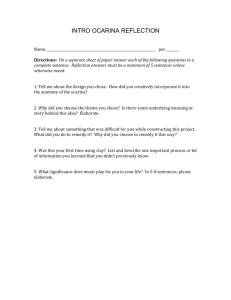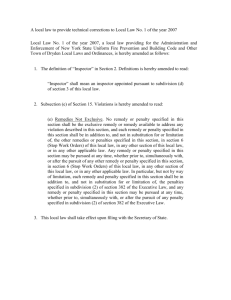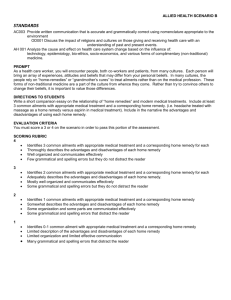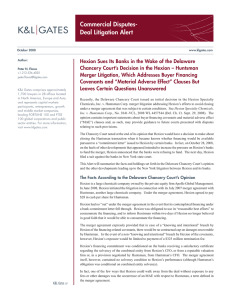DEAL LAWYERS - Richards, Layton & Finger
advertisement
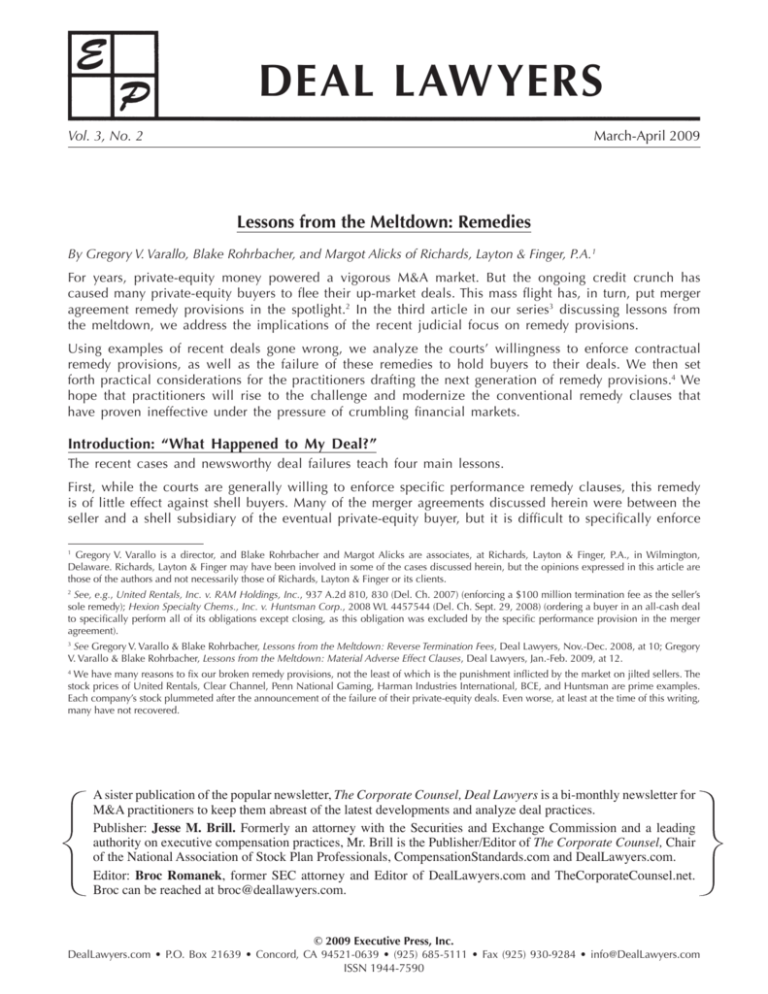
DEAL LAWYERS Vol. 3, No. 2 March-April 2009 Lessons from the Meltdown: Remedies By Gregory V. Varallo, Blake Rohrbacher, and Margot Alicks of Richards, Layton & Finger, P.A.1 For years, private-equity money powered a vigorous M&A market. But the ongoing credit crunch has caused many private-equity buyers to flee their up-market deals. This mass flight has, in turn, put merger agreement remedy provisions in the spotlight.2 In the third article in our series3 discussing lessons from the meltdown, we address the implications of the recent judicial focus on remedy provisions. Using examples of recent deals gone wrong, we analyze the courts’ willingness to enforce contractual remedy provisions, as well as the failure of these remedies to hold buyers to their deals. We then set forth practical considerations for the practitioners drafting the next generation of remedy provisions.4 We hope that practitioners will rise to the challenge and modernize the conventional remedy clauses that have proven ineffective under the pressure of crumbling financial markets. Introduction: “What Happened to My Deal?” The recent cases and newsworthy deal failures teach four main lessons. First, while the courts are generally willing to enforce specific performance remedy clauses, this remedy is of little effect against shell buyers. Many of the merger agreements discussed herein were between the seller and a shell subsidiary of the eventual private-equity buyer, but it is difficult to specifically enforce Gregory V. Varallo is a director, and Blake Rohrbacher and Margot Alicks are associates, at Richards, Layton & Finger, P.A., in Wilmington, ­ elaware. Richards, Layton & Finger may have been involved in some of the cases discussed herein, but the opinions expressed in this article are D those of the authors and not necessarily those of Richards, Layton & Finger or its clients. 1 See, e.g., United Rentals, Inc. v. RAM Holdings, Inc., 937 A.2d 810, 830 (Del. Ch. 2007) (enforcing a $100 million termination fee as the seller’s sole remedy); Hexion Specialty Chems., Inc. v. Huntsman Corp., 2008 WL 4457544 (Del. Ch. Sept. 29, 2008) (ordering a buyer in an all-cash deal to specifically perform all of its obligations except closing, as this obligation was excluded by the specific performance provision in the merger agreement). 2 See Gregory V. Varallo & Blake Rohrbacher, Lessons from the Meltdown: Reverse Termination Fees, Deal Lawyers, Nov.-Dec. 2008, at 10; Gregory V. Varallo & Blake Rohrbacher, Lessons from the Meltdown: Material Adverse Effect Clauses, Deal Lawyers, Jan.-Feb. 2009, at 12. 3 We have many reasons to fix our broken remedy provisions, not the least of which is the punishment inflicted by the market on jilted sellers. The stock prices of United Rentals, Clear Channel, Penn National Gaming, Harman Industries International, BCE, and Huntsman are prime examples. Each company’s stock plummeted after the announcement of the failure of their private-equity deals. Even worse, at least at the time of this writing, many have not recovered. 4 A sister publication of the popular newsletter, The Corporate Counsel, Deal Lawyers is a bi-monthly newsletter for M&A practitioners to keep them abreast of the latest developments and analyze deal practices. Publisher: Jesse M. Brill. Formerly an attorney with the Securities and Exchange Commission and a leading authority on executive compensation practices, Mr. Brill is the Publisher/Editor of The Corporate Counsel, Chair of the National Association of Stock Plan Professionals, CompensationStandards.com and DealLawyers.com. Editor: Broc Romanek, former SEC attorney and Editor of DealLawyers.com and TheCorporateCounsel.net. Broc can be reached at broc@deallawyers.com. © 2009 Executive Press, Inc. DealLawyers.com • P.O. Box 21639 • Concord, CA 94521-0639 • (925) 685-5111 • Fax (925) 930-9284 • info@DealLawyers.com ISSN 1944-7590 a contract against a shell with no independent financial ability to close. In these situations, we often saw the buyer suing its financing sources to compel them to perform their obligations under the financing agreements, while the seller was suing the buyer to force it to close the transaction. The Clear Channel TV/Providence deal is a fairly good example of this paradigm.5 Second, drafting matters. This next lesson is learned from following the effects of ambiguous or conflicting merger agreement remedy provisions. These deals typically ended up in court, where judges had to pick through parol evidence, including the parties’ negotiating history, to enforce the contract. The United Rentals/Cerberus transaction is the poster child for this group of deals.6 The third lesson is the tendency of remedy provisions to fall short of their function—rather than locking buyers into deals, they often provided only a guidepost for renegotiation. These merger agreements were drafted in a seller’s market, and thus typically contained seller-friendly remedy provisions, but these provisions did little to prevent the wave of recently aborted mergers. Harman Industries is a good example. In that deal, a consortium of private-equity buyers declared a material adverse change, renegotiated their transaction, and eventually made a substantial investment in the target in addition to paying the contracted-for break-up fee.7 Unfortunately, Harman’s stock fell sharply as the deal unwound and has yet to recover. The fourth and final lesson from the meltdown is that the courts have proven to be harsh on buyers exhibiting bad behavior. The legal maxim pacta sunt servanda8 still holds considerable force, and buyers seeking a painless escape from a now-disfavored deal through less than forthright behavior may find themselves in worse pain. The best example of this group is the Hexion/Huntsman deal. Hexion was held to have knowingly and intentionally breached its agreement with Huntsman when it hired a firm to render an insolvency opinion, and then made that opinion public, knowing that this would make financing for the deal impossible to procure.9 As a result, the Court of Chancery set aside the contractual cap on Hexion’s liability for damages, and shifted the burden of proof on the question of causation to Hexion. We examine each of these lessons below and set forth proposals for practitioners to consider when trying to avoid the fates faced by the merger parties described in this article. Specific Performance: Liberally Granted, But of Little Help Against Shell Buyers Recent decisions have illustrated the courts’ commitment to enforcing contractual provisions for specific performance.10 But—while parties may contract for this remedy, even in an all-cash deal—the courts’ willingness to order specific performance according to a deal’s terms may be worthless to a seller in the current market context, particularly when its merger counterparty is a shell corporation with few or no assets. Specific performance is an equitable remedy that may be granted when there is no adequate remedy at law.11 For that reason, the remedy has traditionally been unavailable when money damages would be sufficient to make the plaintiff whole, though the courts have been willing to award specific performance to buyers and sellers alike.12 A court could refrain from awarding specific performance to a seller in an 5 See Andrew Ross Sorkin & Michael J. de la Merced, Lawsuit Is Settled over Sale of Clear Channel’s TV Unit, N.Y. Times, Mar. 15, 2008, at C3. 6 See United Rentals, 937 A.2d 810. John Carney, Another One Bites The Dust: KKR and Goldman Kill Harman Deal and Walk Away with Treasure Chest of Convertible Notes, ­Dealbreaker, Oct. 22, 2007, available at http://dealbreaker.com/2007/10/another-one-bites-the-dust-kkr.php. 7 8 Loosely translated as: “A deal is a deal.” See infra at text accompanying notes 40-44. The Hexion opinion showed the Court’s willingness to apply the doctrine of specific performance generously, and the parties eventually reached a $1 billion settlement. Yet despite this massive cash infusion, and the very real possibility of even more to come from Huntsman’s suit against the non-performing banks, Huntsman’s stock has been devastated. Huntsman stock has fallen from the mid-twenties (where it was supported by the $28 deal price) to a recent trading range around $3 per share. 9 10 See infra notes 12-14. Courts see specific performance as “an extraordinary remedy, appropriate where assessing money damages would be impracticable or would fail to do complete justice.” W. Willow-Bay Court, LLC v. Robino-Bay Court Plaza, LLC, 2007 WL 3317551, at *12 (Del. Ch. 2007) (emphasis added). 11 Cf. IBP, Inc. v. Tyson Foods, Inc., 789 A.2d 14, 83 (Del. Ch. 2001) (“This court has not found, and Tyson has not advanced, any compelling reason why sellers in mergers and acquisitions transactions should have less of a right to demand specific performance than buyers, and none has independently come to my mind.”). 12 Deal Lawyers March-April 2009 2 all-cash deal since cash is the quintessential “adequate remedy at law.”13 Nevertheless, the Hexion Court’s commitment to the parties’ contractual arrangement led it to order the buyer to specifically perform all of its obligations except closing.14 Hexion likely viewed the Court’s order as a distinction without a difference; the order left Hexion with no real choice but to try to close the transaction,15 and in its attempt to fulfill its obligations under the contract, it filed suit against the banks that had refused to fund the transaction.16 While Hexion left open the question whether a court will order specific performance of the obligation to close an all-cash deal, the Court’s dicta implies that, had the agreement entitled Huntsman to seek that remedy, the Court would have granted it.17 The Court’s willingness to grant specific performance broadly, bounded only by the restrictions of the contract itself, may foreshadow the likely outcome of the foundering Dow/Rohm & Haas deal currently moving through Delaware’s Court of Chancery.18 Nonetheless, the availability of specific performance is of little help when directed at a shell corporation, and many private-equity buyers used a shell subsidiary to sign the merger agreement with the seller.19 An example of this structure is the two-tiered Clear Channel deal, in which Providence Equity Partners was to pay $1.225 billion for the Clear Channel TV stations, after which Bain Capital and THL Partners were to pay $39.20 a share for the remainder of Clear Channel. In the first tier of litigation over this deal, Wachovia sued its own client, Providence, to avoid funding the transaction, while Providence was simultaneously being sued in an attempt by Clear Channel to ensure consummation of the deal.20 Vice Chancellor Strine took the opportunity, during a hearing on Clear Channel’s motion to expedite, to address the impotence of specific performance as a remedy against a shell buyer.21 The Providence deal provided Clear Channel with the remedies of both specific performance and a two-tiered $45 million reverse termination fee.22 The parties disputed the intended extent of the specific performance provision, The Court in IBP reasoned that the typical justification for an order of specific performance is that the merger transaction will create a unique “value of an unquantifiable nature,” and that, in that case, the “sell-side of the transaction [was] able to make the same argument, because the Merger Agreement provide[d] the IBP stockholders with a choice of cash or Tyson stock, or a combination of both. Through this choice, the IBP stockholders were offered a chance to share in the [merger’s] upside . . . .” Id. at 83. The Delaware courts have been willing to grant specific performance where money damages would be “staggeringly large” and imprecise, id., or would be “impossible” to measure, Cheese Shop Int’l, Inc. v. Steele, 311 A.2d 870, 871 (Del. 1973). 13 Section 8.11 of the Hexion-Huntsman Merger Agreement provided that all obligations, except the obligation to close, would be specifically enforceable. Hexion, 2008 WL 4457544, at *31. The Court granted the contracted-for specific performance despite the fact that “Hexion and Huntsman signed a merger agreement whereby Hexion agreed to pay $28 a share in cash for 100% of Huntsman’s stock.” Id. at *3 (emphasis added). 14 “Hexion will remain free to choose to refuse to close…. [I]f Hexion’s refusal to close results in a breach of contract, it will remain liable to ­Huntsman in damages.” Id. at *32. 15 Following the Delaware Court of Chancery’s decision in favor of Huntsman, Hexion took steps to perform its court-ordered obligations under the merger agreement by filing suit against Credit Suisse and Deutsche Bank in the Supreme Court of the State of New York on October 29, 2008, for their refusal to fund the merger. 16 The Court stated in a footnote that, “[i]f the clause was meant as Huntsman argues in its post-trial brief, it would be a rare case that Huntsman would not be entitled to specifically enforce the consummation of the merger.” Hexion, 2008 WL 4457544, at *32. The Court did not rest its refusal to enjoin the parties to close on a traditional specific performance analysis, but rather found that it was prevented from finding that Huntsman could force Hexion to close by the contract itself, as described in Huntsman’s own proxy materials. Id. 17 The merger agreement at issue in the Dow/Rohm deal is extremely tight, despite having been negotiated after the onset of the credit meltdown, as evidenced by a material adverse effects clause that specifically carves out a potentially worsening financial market and the conspicuous absence of a “financing out.” Complaint at 2, 6, Rohm & Haas Co. v. Dow Chem. Co., C.A. No. 4309-CC (Del. Ch. Jan. 26, 2008), available at http://www. rohmhaas.com/assets/attachments/acquistion/roh_v_dow_012609.pdf. Under this contract, Dow agreed to pay Rohm & Haas $78 per share, for an all-cash total of around $15 billion. See Andrew Ross Sorkin, Dow Chemical to Buy Rohm and Haas for $15.3 Billion, N.Y. Times, July 10, 2008, available at http://dealbook.blogs.nytimes.com/2008/07/10/dow-chemical-to-buy-rohm-and-haas-for-153-billion/. Unlike the agreement at issue in Hexion, the Dow/Rohm agreement explicitly provides for the remedy of specific performance, without any conditions or limitations. Complaint at 7, C.A. No. 4309-CC. Given the all-cash consideration in this deal, the Court will likely provide a ruling on whether the all-cash nature of a transaction will or will not preclude the equitable remedy of specific performance. 18 Steven M. Davidoff, The Failure of Private Equity, 82 S. Cal. L. Rev. (forthcoming 2009), available at http://www.law.uiuc.edu/_shared/pdfs/ davidoffpaper.pdf. 19 See Sorkin & de la Merced, supra note 5. The second stage of this deal also gave rise to numerous lawsuits. The consortium of six banks sponsoring the larger Clear Channel/Bain-THL deal tried to avoid their funding obligations. The private-equity firms then sued the banks to enforce the debt commitment letters. Clear Channel intervened in that action and filed its own suit in Texas, claiming the banks were culpable for tortious interference with contract. The deal eventually closed at $36 a share, roughly $3 less than the original deal price. 20 “I think your friends are going to say, ‘Mr. Scaggs [Counsel for Clear Channel], the only entities against which the Court can enter an order [of specific performance] are these [shell] entities, and they have whatever resources they do.’ The contract specifically disclaims any ability on the part of your clients to pierce their veil and go after the parents. So if these entities default, they default.” Clear Channel Broad., Inc. v. Newport Television LLC, C.A. No. 3550-VCS, at 23 (Del. Ch. Feb. 26, 2008) (TRANSCRIPT). 21 22 Id. at 32. 3 Deal Lawyers March-April 2009 but the Vice Chancellor—after addressing the practical difficulties involved in attempting to compel a subsidiary to take any action disfavored by its private-equity parent—was inclined to take a more realistic approach: payment of the reverse termination fee as a means to end the litigation.23 While Clear Channel ultimately resulted in a renegotiated resolution, it is quite clear that the remedy of specific performance is not a practical pursuit where the buyer is a shell corporation, unless the shell buyer can be compelled to sue on its debt and equity commitments. Of course, even where the shell buyer agrees unambiguously to sue its financing sources under certain circumstances, this provision is likely to be of cold comfort to a seller unable to determine whether its buyer’s debt and equity commitments are airtight and enforceable. Perhaps more focus on parent guarantees, or simply more adequate reverse break-up fees, may help future sellers mitigate the effects of dealing with a shell buyer.24 Drafting 101: The Perils of Ambiguity The merger agreements in several defunct deals—including Clear Channel, Penn National Gaming, BCE, URI, and Hexion—included the remedies of both specific performance and liquidated damages. Ambiguous relationships between those different remedies provided private-equity buyers with opportunities to renegotiate or to escape altogether. Sellers’ counsel can avoid such results through careful drafting and ex ante consultation with litigators. The Clear Channel TV deal with Providence Equity Partners illustrates the wiggle room available to a buyer when remedy provisions are ambiguous. In the hearing on Clear Channel’s motion to expedite, Vice Chancellor Strine recognized the issue of ambiguous drafting, comparing the situation to that in United Rentals: “This is where I think if people want not to have specific performance remedies, they would be best [served by] avoiding putting them in contracts.”25 Strine struggled, as the Court had in United Rentals,26 to determine what meaning could be found in an ambiguous specific performance provision directed at a shell subsidiary with no assets. The language at issue in United Rentals was much more troubling than the “ambiguity-lite” that had troubled the Court in the Clear Channel TV and Huntsman27 agreements. The URI–RAM deal contained remedy provisions that arguably directly conflicted with each other. The agreement contained a specific performance provision, “subject to” another provision in the contract, which in turn provided for a termination fee as the sole remedy for breach.28 To resolve the conflict, the Court looked to extrinsic evidence to determine the parties’ objective understanding.29 Ultimately, the Court employed the “forthright negotiator” principle to determine which party would win the day.30 The two remedy provisions were found to be hierarchical; the specific performance provision was subordinated to the termination fee term in such a way that Cerberus was able to pay the fee and terminate the deal as though the specific performance provision were nonexistent.31 These cases illustrate, if nothing else, the importance of knowing what you are bargaining for. Id. at 20-35. The Vice Chancellor made his position known to counsel for Clear Channel: “I can’t specifically order [the buyer shells] to close the transaction. Right?” Id. at 21. 23 The Court of Chancery recently, in an analogous situation, made clear the perils of failing to secure agreements from responsible parties on the other side of the deal. See Alliance Data Sys. Corp. v. Blackstone Capital Partners V.L.P., 2009 WL 117563 (Del. Ch. Jan 15, 2009). In this opinion, Vice Chancellor Strine noted that “ADS knew with whom it was contracting and with whom it was not. The bottom line for ADS is that it only contracted with Aladdin, and in § 5.2 simply got an assurance that Aladdin had the authority and power to do all that it was required to do under the Merger Agreement. ADS has made no allegation that Aladdin lacked such power as to its own duties. The fact that ADS wishes it had struck a bargain with Blackstone directly does not change the reality that ADS knew that the Merger Agreement did not impose obligations on Blackstone directly.” Id. at *19. 24 25 Clear Channel Broad., C.A. No. 3550-VCS, at 36. 26 United Rentals, 937 A.2d 810. The Court noted that the meaning of the specific performance provision in Hexion was unclear, and proceeded to apply a well-settled analysis to the ambiguous term, looking to extrinsic evidence to determine its meaning. Hexion, 2008 WL 4457544, at *31. 27 28 United Rentals, 937 A.2d at 831-33. “[T]he threshold inquiry when presented with a contract dispute … is whether the contract is ambiguous.” Id. at 830. “Having determined that the contract is ambiguous … the Court permitted the parties to introduce extrinsic evidence of the negotiation process.” Id. at 834. 29 30 Id. at 818-19. 31 Id. Deal Lawyers March-April 2009 4 Indeed, while the United Rentals Court mused in passing that parties could deliberately include a certain degree of ambiguity in their contracts,32 we would suggest that deals where such ambiguity is reached affirmatively and purposefully are few and far between. Instead, the vast majority of cases with ambiguous remedy provisions involve poorly drafted forms used simply because they have been used before, and often without the review of litigators. The number of cases with “broken” remedies provisions suggests that it is time for deal lawyers to review those provisions carefully, with their litigation partners, and look closely at any potential conflict in the remedy provisions. The “Remedy” of Renegotiation In several deals, while the parties stayed out of court, the remedy provisions still did not operate quite as designed. Many private-equity buyers have used litigation (or the threat of litigation) as part of a strategy to renegotiate or settle with their sellers on terms that are more realistic in a volatile credit market.33 Despite the high bar Hexion set for declaring a material adverse effect,34 doing so may still be a fruitful strategy if the goal is renegotiation. Of course, declaring an MAE may itself lead to a finding of breach,35 so invocation of the clause is not for the timid. The Penn National Gaming deal was renegotiated in the face of Penn National’s right to compel its private-equity buyers Fortress Investment Group and Centerbridge Partners to enforce their debt and equity commitment letters. This deal included a $200 million reverse termination fee and a broad right to obtain specific performance in lieu of termination.36 The provisions were broad enough that the parties resolved to terminate the deal and renegotiate an agreement under which Penn National received $225 million as a termination fee and $1.25 billion as an equity investment, instead of the $67 a share it had originally bargained for.37 These examples demonstrate that, given a buyer determined to break a deal against the backdrop of a desolate credit market, optionality may be unavoidable. The parties’ best hope may be a reverse termination fee. If parties choose to negotiate for such a fee, the upward limit on its amount would be determined pursuant to a liquidated-damages analysis like that articulated in Brazen v. Bell Atlantic,38 as distinguished from the ceiling on forward termination fees provided by a seller’s fiduciary obligations.39 Buyers Behaving Badly The last theme we explore involves buyers who attempted to escape deals using unfair tactics. Hexion is the prime example, for attempting to avoid closing its deal with Huntsman while, at the same time, assuring that, if any termination fee were due, it would be limited by an agreed-on damages cap. The result was a disaster for Hexion and its private-equity sponsor, Apollo. The Court recognized that “[t]he law of contracts … does not require parties to choose optimally clear language; in fact, parties often riddle their agreements with a certain amount of ambiguity in order to reach a compromise.” Id. at 844 (footnote omitted). 32 Some buyers may go a step further and threaten to file for bankruptcy in an effort to escape their undesirable deals. For example, in the spring of 2008 seller James Cable sued Millennium Digital Media Systems (now known as Broadstripe), seeking damages for Broadstripe’s breach of its agreement to purchase the assets of James Cable. See Verified Amended Complaint, James Cable, LLC v. Millennium Digital Media Sys., LLC, C.A. No. 3637-VCL (Del. Ch. Apr. 24, 2008). Broadstripe then filed for chapter 11 protection on January 2, 2009. See Lorraine Mirabella, Cable Firm Broadstripe Files for Bankruptcy, Balt. Sun, Jan. 6, 2008. For the purposes of a seller seeking specific performance, a bankrupt buyer is just as forbidding as a solvent shell. 33 34 See Varallo & Rohrbacher, Material Adverse Effect Clauses, supra note 3, at 12. Cf. Frontier Oil Corp. v. Holly Corp., 2005 WL 1039027 (Del. Ch. Apr. 29, 2005), where Frontier sought substantial monetary damages under the claim that Holly had repudiated the merger agreement when it wrongfully declared an MAE. 35 36 Penn National Gaming, Inc., Definitive Proxy Statement (Schedule 14A), at 90-91 (Nov. 7, 2007). 37 See Michael J. de la Merced, Penn National Gaming Cancels Its Sale to Private Equity Firms, N.Y. Times, July 4, 2008, at C3. Brazen v. Bell Atl. Corp., 695 A.2d 43 (Del. 1997). The Brazen Court articulated a two-prong test for determining the enforceability of a liquidated damages provision that requires a reasonable amount to be set in light of uncertain damages. Id. at 48. Two factors relevant to the Court’s determination of the second prong are: (1) “the anticipated loss by either party should the merger not occur” and (2) “the difficulty of calculating that loss.” Id. at 48. In negotiating a $550 million termination fee in Brazen, the parties took into account their lost opportunity costs, the expenses they incurred, the size of the termination fees in merger transactions that had been considered valid by other courts, and the size of the transaction. Id. at 49. The Court upheld this amount as reasonable in light of these factors. Id. To ensure that a high reverse termination fee will not be deemed a penalty, deal counsel should consider these factors in the course of their negotiations. 38 39 See Varallo & Rohrbacher, Reverse Termination Fees, supra note 3, at 10. 5 Deal Lawyers March-April 2009 In Hexion, Vice Chancellor Lamb had to decide whether Hexion had committed a knowing and intentional breach of its covenants to “use its reasonable best efforts to take all actions and do all things ‘necessary, proper or advisable to consummate the financing’” and to refrain from acting in a way that could “‘reasonably be expected to materially impair, delay or prevent consummation’ of such financing.”40 The Court found that Hexion had knowingly and intentionally breached these covenants by obtaining an insolvency opinion “produced with the knowledge that the opinion would potentially be used in litigation, … based on skewed numbers provided by Apollo, and … produced without any consultation with Huntsman management.”41 Hexion published that opinion in a press release, and immediately thereafter filed a complaint “alleging a belief that the merger [could not] be consummated since the financing [would] not be available.”42 Hexion believed that obtaining an insolvency opinion, publishing it, and filing suit based on it were all acceptable efforts towards its declaration of a material adverse effect under the merger agreement.43 The Court found that, because Hexion’s measures essentially guaranteed that the financing would be unavailable, Hexion had in fact knowingly and intentionally breached the merger agreement. The Court’s finding had the effect of eliminating the $325 million cap on damages for Hexion’s breach.44 The Court’s finding sent a clear message: try as you might to twist deal terms into an exit strategy, bad buyer behavior will not be tolerated. As for Hexion, it eventually settled for $1 billion, including an investment in Huntsman, thereby avoiding potential liability for Apollo and its principals while keeping its lawsuit against the banks alive.45 Nor is Hexion anomalous. The consortium of buyers who had agreed to take BCE private, in what was to be the largest leveraged buyout in history, attempted to walk away from their transaction without paying the agreed-on termination fee. The deal disintegrated when KPMG, the accountants for forsaken seller BCE, declared that the post-purchase company would fail a solvency test.46 Despite the fact that KPMG’s positive solvency opinion of the post-buyout company was a condition of closing negotiated for and inserted in the agreement by the seller,47 the buyers relied on the KPMG opinion in terminating the merger agreement. BCE sued its would-be buyers in Canada for the billion-dollar fee, arguing that the sellers had prematurely terminated the agreement.48 It will be interesting to learn whether, as in Hexion, the Canadian litigants choose to settle their differences and, if not, whether the Canadian court determines that the buyers in the BCE deal behaved badly in attempting to walk without paying BCE its fee. Practical Implications • Specific performance is widely available but may be insufficient to protect both buyers and sellers. The cases we discussed in this series demonstrate the courts’ agreement-honoring approach. The courts’ willingness to enforce specific performance indicates an opportunity for deal lawyers to get creative with the scope and functioning of the specific performance remedy in their agreements. But, as was obvious in several of the broken deals described above, specific performance is unlikely to be meaningful when directed at a buyer’s shell subsidiary. The parties may prefer to negotiate for a reverse termination fee, or for stronger parent guarantees, to provide buyers with flexibility and sellers with a cushion for future deal fallout. 40 Hexion, 2008 WL 4457544, at *1. 41 Id. at *6. 42 Id. at *1. 43 Id. at *2. The Court did not decide damages, however, and left that for later proof. Id. at *28 (“Because of the difficulty in separating out causation of ­ amages in such an action, the burden will be on Hexion to demonstrate that any particular damage was not proximately caused by its knowing d and intentional breach. To the extent Hexion can make such a showing, those damages which were not proximally caused by Hexion’s knowing and intentional breach will be limited to the liquidated damages amount of $325 million, pursuant to section 7.3(d) of the merger agreement.”). 44 The trial in Hexion’s action against Credit Suisse Group and Deutsche Bank is set for later this year. See Peter Lattman, Apollo’s Hexion Sues Banks over Funding on Huntsman, Wall St. J., Oct. 30, 2008, at C3. 45 46 Wojtek Dabrowski, BCE Sues Would-Be Buyers over C$1.2 Bln Break Fee, Dec. 18, 2008, available at http://in.reuters.com/article/mergersNews/ idINN1734946520081217. See Andrew Ross Sorkin & Steven M. Davidoff, Four Buyouts of the Apocalypse: Bell Canada, N.Y. Times, May 20, 2008, available at http:// dealbook.blogs.nytimes.com/2008/05/20/. 47 48 Id. Deal Lawyers March-April 2009 6 • Reverse termination fees provide a reliable alternative to innovation. Parties to a merger may be more comfortable relying on a reverse termination fee as an alternative to innovating other remedy terms such as specific performance or MAE clauses. A seller may use the desirability of the reverse termination fee as a bargaining chip in securing a higher fee amount. In such a negotiation, deal counsel should shift their focus from the fiduciary considerations that restrict forward termination fees to a liquidateddamages analysis.49 This should prevent subsequent invalidation of the fee as a penalty, mitigate the seller’s losses in the event of fallout, and provide the buyer with a reliable exit strategy. • Interplay of conflicting remedy provisions. Deal lawyers should take care to draft remedy provisions that have a clear relationship or hierarchy. Counsel should take advantage of the courts’ willingness to enforce remedy provisions by using clear language. If counsel plainly set forth how each remedy functions (and interacts with other terms), the parties can rely on the agreement when deciding whether to run with—or away from—a deal. • Post-deal behavior matters. Buyers should be aware that courts may not let them out of their deals scot-free if their behavior is later determined to have been inequitable. Counsel should keep this in mind when advising a buyer on whether it should take a questionable stance based on ambiguous deal terms in an effort to instigate a renegotiation. Counsel should also be careful to consider the difficulties involved when drafting a conditional damages cap. To avoid Hexion’s fate, drafters should ensure that the condition and its interaction with other terms are clear to the parties, both during the deal negotiations and as memorialized in the final deal documents. The courts have demonstrated their commitment to enforcing a broad scope of contractual remedy provisions. This emerging case law should give counsel the confidence and latitude to draft innovative contractual remedies to deal with current market conditions. Private-equity investors may be quiet now, but they will return when credit begins to flow again. Upon private equity’s return, it should meet a new generation of MAE clauses, specific performance terms, and separately negotiated reverse termination fees. In light of the cases we have discussed in this series and with the experience of the credit meltdown in the background, deal counsel should reexamine their reliance on outmoded remedy provisions. This downturn provides an opportunity to create remedy provisions more likely to achieve both buyers’ and sellers’ legitimate expectations, and thereby more likely to promote deal certainty. 49 See supra note 38; see also Varallo & Rohrbacher, Reverse Termination Fees, supra note 3, at 10. 7 Deal Lawyers March-April 2009


